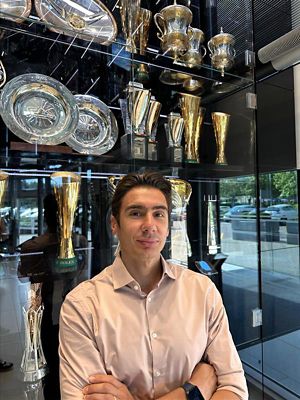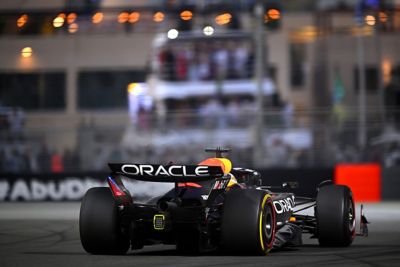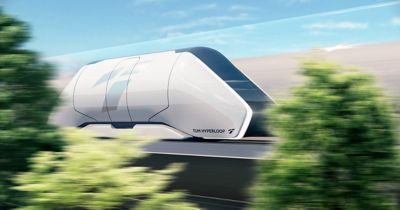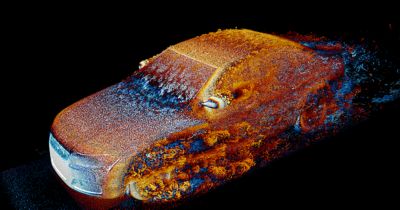In this installment of “Ask the Engineer,” you’ll learn how Ansys software drives an important aspect of Formula One racing, turn by turn.
Warming up for the Las Vegas Grand Prix the last weekend in November, Oracle Red Bull Racing driver Max Verstappen described his one-lap pace as being “quite far off” from his expectations that day. It was slippery, and the struggle to make the tires work in unusually cold conditions was real, giving the team a real challenge in maximizing grip and traction.
So, what was it that caused Verstappen and the rest of his team these challenges during practice? Was it the tires or something else?
Indeed, tire strategy is a big part of Formula One. It requires 13 sets of Pirelli dry weather tires over the course of one weekend. There are two sets of hard tires, three sets of mediums, eight sets of softs, four sets of intermediates, and three sets of wets. They’re designated from C1 (the hardest) to C5 (the softest) to respond to a wide range of conditions, except for the intermediates and wets, which are designated for rainy days.
With the exception of the rain tires, all are slicks, meaning they have no tread. This enables them to make better contact with the track surface, becoming sticky as they heat up to get a good grip. They are standard issue in Formula One, meaning that all teams are required to race on the same set.
During the Las Vegas Grand Prix, Verstappen acknowledged that conditions, including the tires, were the same for everyone, yet seemingly few struggled to get a grip on the track.
We recently interviewed Gennaro Serino, computational fluid dynamics (CFD) tools and methods team leader at Oracle Red Bull Racing and Red Bull Technology, to hear about the team’s use of Ansys simulation to balance tire performance with vehicle aerodynamics.
How significant is aerodynamic strategy during a race?
Gennaro Serino: Each race has its own aero package, in the sense that the aerodynamics need to be adjusted according to the track. If you’re running your car on a street circuit like Monaco, the car’s components would be completely different from running the car in, let’s say, Monza, where teams favor a low-downforce setup to minimize drag and maximize performance on the straights.
Aero development in general impacts strategy a lot during the race because you need to adjust your car and your setup according to the race itself. If a track is a mix of straights where you should have very high straight-line speeds versus going through corners where you require a lot of driving, you need to prioritize high-speed performance toward low-speed performance. So, you need to adjust your wings or other things that affect the driving style through those corners.
Where do tires come into play?
Serino: Everyone has the same tires in Formula 1. And while you can’t necessarily change the tires, you can build an aero strategy around tire wear. It’s one of the aero strategies of the car design itself to minimize that wear.

Gennaro Serino, computational fluid dynamics (CFD) tools and methods team leader at Oracle Red Bull Racing and Red Bull Technology
For instance, if you’re choosing a high-downforce package, you are putting a lot of pressure on the tires. That will affect tire wear because you’re continuously pushing the car toward the ground because of the high downforce. For a low-downforce case, it’s the opposite. You’re choosing the low-degradation type of style with respect to the previous one. You see that during races or race events teams choose different styles because of other packages they have.
It’s a matter of both strategy during the race and also the driving style of the driver. For example, some drivers like driving with the front end a lot, meaning that they want a lot of downforce on the front of the car. They want to basically feel the pressure, or the downforce on the front of the car, when they steer. They want a lot of contact with the tires on the front because they want to feel the car steering through the corner.

The RB20 driven by Max Verstappen corners at the 2024 Abu Dhabi Grand Prix.
What can happen in a race without the proper tire aero strategy?
Serino: Sometimes the atmospheric temperature during the race itself is out of range. It’s different with respect to the conditions that you have tested, say, on Friday and Saturday. Even slight temperature changes can alter the optimum window for the working tire. You have to throw your previous assumptions out the window. Because if you are expecting cooler temperatures, you’re expecting your tire to last 20 laps. Instead, they are lasting 10 laps.
So, you need to adjust your strategy accordingly. But it’s something that you need to work out during the race itself because it’s something that cannot be predicted before. Fortunately, we can use previous simulation data or the data that we have for the weekend. In this way, even with rapidly changing conditions, we can still adjust the strategy.
Tire failure happens very rarely. But of course, a puncture can happen. When there is one, an F1 tire can still perform well enough so the driver is safe to drive back to the pit and change the tire. You don’t see explosions of tires on the track. It’s pretty rare, really quite impossible, because of the safety measures taken in tire construction.
In terms of CFD, what are some of the things you’re optimizing for?
Serino: When we do tire simulations in Ansys Fluent fluid simulation software, temperature, individual track surfaces, and materials are all taken into account. These boundary conditions are essentially the parameters that you need to specify so that your model matches reality.
You can simulate, for example, different tracks with different surfaces by modifying the microroughness of the ground in your simulations. And this affects a lot, including the all-around performance and the outcome of your simulations. This roughness is also something that you can account for on the tire tread because visually the treads are subject to wearing.
During the race, you see that the tire surface gets dirty, causing additional wear. A dirty surface generates a different kind of weight or different kind of performance with respect to a shiny tire. You can take this into account by increasing the parameters that control the surface quality of the tire — something you can easily consider in simulations.

The Red Bull crew returning a set of medium compound tires to the garage after a pit stop
Can you provide an example of a challenge that you solved using simulation with tires and aero?
Serino: There were some cases in the past where we saw some degradation of performance during the lap because of tire wearing, but we couldn’t understand what the aerodynamic effect was. From track footage, we discovered basically that when the car went into the lap and tire wearing started to come into play, the tire began to deform in an unusual way. After several laps, a bit of damage formed on the tire for reasons we had not seen before.
To better understand this effect, we managed to replicate the issue within Ansys Fluent. That gave us the right answer in terms of what was causing the degradation of performance and how to stop it.
Speaking of challenges, how have Formula One regulatory changes between 2021 and 2022 impacted aerodynamic tire strategy for the team?
Serino: When you have bigger tires, you have a lot of turbulence generated from the front tires to the back of the car. That’s affecting your performance a lot because essentially you’re sending dirty air (turbulent or unfiltered air) toward the rear of the car. The dirty air would go outward, chewing up the tires. The rear of the car is not clean, so you need to adjust or direct the floor field, or the aerodynamics underneath the car, in a way that all of this additional weight caused by the dirty air is pushed out. We call that outwash.
Formula 1 car floors have aero channels that filter the air under the floor to the back of the car. With these and other modifications, the clean air comes out of the back, through the side of the car (side pod) under the car, and under the floor, making it more aerodynamic. It also makes the race more competitive, as other cars can follow much closer behind you.

Max Verstappen celebrates his fourth consecutive world championship in Las Vegas on Nov. 23, 2024.
What would you say is the biggest benefit of using Ansys software in your work?
Serino: In an Ansys CFD simulation, you have the freedom to do whatever you want aerodynamically with vehicle design. This leads to some new ways of doing things.
In one instance, we discovered that by pushing the car very close to the ground, we could find a good amount of performance. This was something that was not visible to us in the winter. We could investigate in a virtual environment what was happening, correlate that with what we already know, and make additional improvements based on our findings. And of course, every improvement we discover moves us that much closer to the podium.
We’re so grateful for Gennaro Serino’s insights as a motorsport engineer for one of the most dominant teams in Formula One history. If you’re interested in learning more about Oracle Red Bull Racing’s use of simulation, download the white paper "Oracle Red Bull Racing's Use of Ansys Simulation Paves the Way to Track Success."
And, if you're attending CES this year, stop by the Ansys booth 6400 in the Las Vegas Convention Center – West Hall to see the ORBR car in person and chat with industry experts.
Just for you. We have some additional resources you may enjoy.
“In an Ansys CFD simulation, you have the freedom to do whatever you want aerodynamically with vehicle design. This leads to some new ways of doing things.”
— Gennaro Serino, computational fluid dynamics (CFD) tools and methods team leader, Oracle Red Bull Racing and Red Bull Technology















